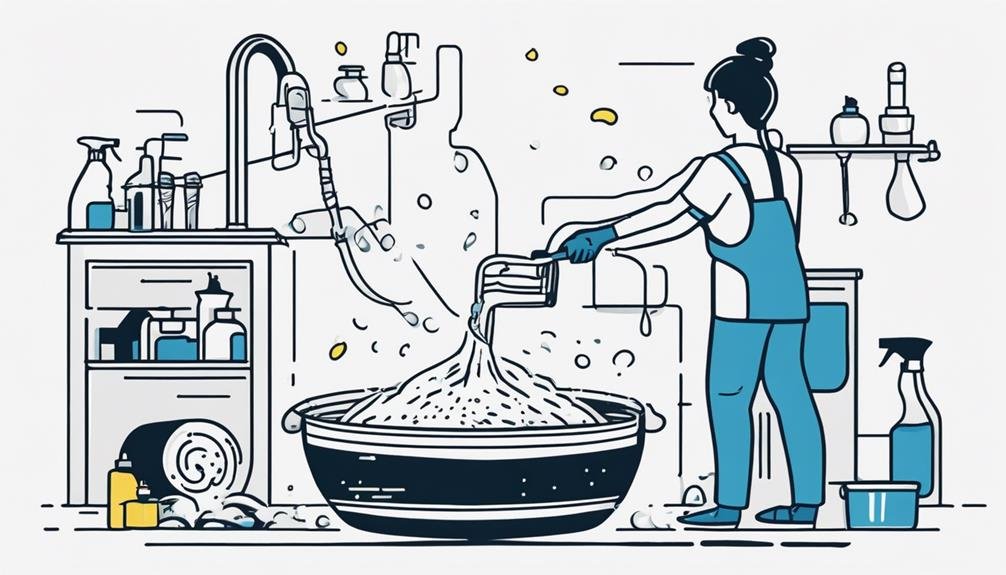Tired of throwing money down the drain on professional septic tank cleanings?
You may be surprised to learn that there are effective DIY solutions right at your fingertips. From simple ingredients in your pantry to eco-friendly techniques, taking care of your septic system can be both cost-effective and environmentally conscious.
But before you roll up your sleeves and grab that toolbox, there are a few crucial tips and tricks you need to know to ensure your DIY maintenance is a success.
Key Takeaways
- Cost-effective and eco-friendly solutions with household ingredients
- Maintain bacterial balance for optimal septic tank function
- Prevent costly repairs and extend septic system lifespan
- Tailored, natural alternatives for safe and effective cleaning
Benefits of Homemade Solutions

When tackling septic tank maintenance, utilizing homemade cleaning solutions can offer numerous advantages to homeowners. Not only are these cost-effective solutions, but they also provide natural alternatives to harsh chemicals that can harm the environment.
Homemade solutions often use ingredients readily available in most households, making them convenient and affordable. By opting for DIY cleaning methods, you have the freedom to control what goes into your septic system, ensuring that only safe and eco-friendly materials are used.
These natural alternatives can help maintain the balance of bacteria in your septic tank, promoting optimal breakdown of waste. Additionally, homemade solutions can be tailored to suit your specific needs, whether it's addressing odors, clogs, or overall tank maintenance.
With a bit of knowledge and the right ingredients, you can keep your septic system running smoothly without relying on expensive commercial products. Embracing cost-effective and natural cleaning solutions not only benefits your septic tank but also contributes to a more sustainable approach to home maintenance.
Ingredients for DIY Cleaning
Looking to create effective DIY septic tank cleaning solutions? When it comes to maintaining your septic tank, safety precautions are crucial. For your homemade cleaning solution, you'll need ingredients that are both effective and safe for your system. Commonly used ingredients include baking soda, vinegar, and even yogurt or buttermilk, which can introduce beneficial bacteria to aid in breaking down waste.
Before starting your DIY cleaning, remember to wear protective gear such as gloves and goggles to prevent any accidents. Additionally, ensure proper ventilation in the area where you'll be working. When it comes to cleaning frequency, it's recommended to clean your septic tank at least once every 3-5 years, depending on usage and household size.
Regular maintenance helps prevent costly repairs and prolongs the lifespan of your septic system. By using the right ingredients and following safety precautions, you can effectively maintain your septic tank without the need for harsh chemicals or expensive treatments.
Step-by-Step Cleaning Process

To initiate the step-by-step cleaning process for your septic tank, gather all necessary tools and materials in a designated work area. You'll need cleaning tools such as a sewage pump, a hose, a shovel, and a bucket for debris removal. Before beginning, ensure you take safety precautions by wearing gloves, goggles, and a mask to protect yourself from harmful gases and bacteria present in the tank.
Start by locating the access point to your septic tank and uncover it carefully. Use the shovel to dig around the opening if needed. Next, attach the hose to the sewage pump and lower it into the tank. Turn on the pump to begin removing the liquid waste from the tank, being careful not to disturb the solids settled at the bottom.
Once the tank is emptied, use the shovel and bucket to scoop out any remaining sludge and debris. Thoroughly rinse the tank with clean water using the hose until the water runs clear. Finally, securely close the access point and dispose of the waste properly.
Maintenance Tips for Septic Tanks
For effective septic tank maintenance, prioritize regular inspection and timely pumping to ensure optimal functioning and longevity. Preventative measures play a crucial role in preventing costly repairs and system failures. To keep your septic tank in top condition, avoid flushing non-biodegradable items, chemicals, and excessive amounts of grease down the drains. Be mindful of what goes into your system to prevent clogs and backups.
Troubleshooting tips are essential for identifying potential issues early on. Keep an eye out for warning signs such as slow drains, foul odors, or pooling water around the drain field. Addressing these problems promptly can prevent more significant issues from developing and prolong the life of your septic system. Regularly checking for leaks, inspecting the tank components, and monitoring the water levels are simple yet effective ways to stay on top of maintenance tasks.
Eco-Friendly Cleaning Techniques

To incorporate eco-friendly practices into your septic tank maintenance routine, consider utilizing cleaning techniques that are gentle on the environment and safe for your system. When aiming for green practices, opt for natural alternatives such as using baking soda and vinegar to clean your drains.
Mix 1/2 cup of baking soda with 1/4 cup of vinegar and pour it down the drain, followed by hot water, to help break down grease and prevent clogs without harming the beneficial bacteria in your septic tank. Another eco-friendly option is to use enzymatic cleaners that contain bacteria and enzymes to digest organic matter in your system.
These cleaners are biodegradable and can help maintain a healthy balance of bacteria in your septic tank. By choosing these natural alternatives and green practices, you not only protect the environment but also ensure the longevity and efficiency of your septic system.
Frequently Asked Questions
Can DIY Septic Tank Cleaning Solutions Cause Harm to the Environment or Groundwater?
Using DIY septic tank cleaning solutions can potentially harm the environment and contaminate groundwater. To mitigate risks, follow safety precautions, use proper disposal methods, and consider professional services for effective and eco-friendly maintenance.
How Often Should I Clean My Septic Tank Using Homemade Solutions?
To maintain a healthy septic system, you should clean it using homemade solutions every 6 months. Ensure safety by wearing protective gear, following proper disposal methods, and avoiding harsh chemicals that could harm the environment or groundwater.
Are There Any Specific Types of Septic Tanks That Homemade Cleaning Solutions Are Not Suitable For?
When choosing DIY septic tank cleaning solutions, ensure compatibility with your tank material. Proper dilution ratios are key to prevent damage. Some homemade solutions may not be suitable for certain septic tanks, so research beforehand.
Can Homemade Solutions Be Used as a Replacement for Professional Septic Tank Maintenance?
You should consider the long term effectiveness and costs of DIY vs professional septic tank maintenance. While homemade solutions can be cost effective alternatives with biodegradable ingredients, they may not fully replace professional services.
Are There Any Risks Involved in Using DIY Cleaning Solutions for Septic Tanks, and How Can They Be Mitigated?
Using DIY cleaning solutions for septic tanks can pose risks if not done carefully. To mitigate potential issues, always wear protective gear, follow proper disposal methods, and avoid mixing chemicals. Prioritize safety measures to prevent harm.
Conclusion
In conclusion, maintaining your septic tank with DIY cleaning solutions isn't only cost-effective but also environmentally friendly. By using simple household ingredients and following a few easy steps, you can keep your septic system in top condition.
Remember, a well-maintained septic tank can last for years, saving you thousands of dollars in repairs. So, don't wait until it's too late – start using these homemade solutions today and watch as your septic tank thrives like never before!

